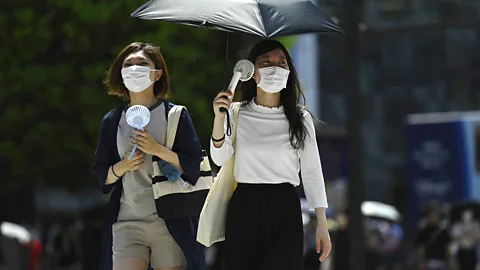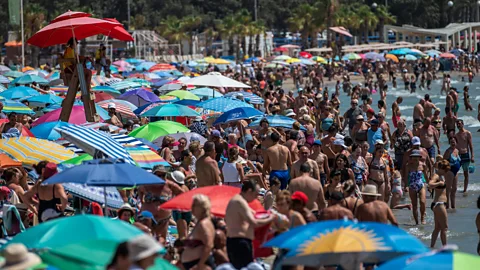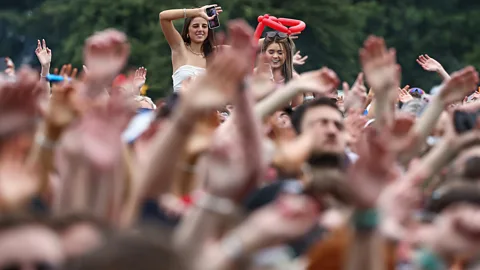Why Covid-19 is spreading this summer
 Getty Images
Getty ImagesCovid-19 doesn't follow normal seasonal patterns, like other respiratory viruses – waves of infection can happen at any time of year.
Every July for the past four years, epidemiologists at the US Centers for Disease Control and Prevention (CDC) have noted a sudden spike in Covid-19 cases and hospitalisations, an annual trend which has been dubbed "the summertime surge".
This summer in the United States, Covid-19 rates are reportedly particularly high in Arizona, California, Hawaii and Nevada. In these western states, the number of positive tests reached 15.6% on the week ending July 6th, 1% up on the previous week. The CDC’s investigations show that viral rates in wastewater are also on the rise once again.
A similar trend has played out on the other side of the Atlantic, where according to the UK's Health Security Agency, positive Covid-19 tests rose from 4% at the end of March to 14% by the end of June.
The recent rise has been attributed to the FLiRT subvariants, the latest evolution of the Omicron strain of Covid-19 which emerged towards the end of 2021. This new raft of subvariants is the inevitable consequence of the virus trying out new mutations in its spike protein – a structure which is essential for Covid-19's ability to enter human cells, but can also alert the human immune system to the virus' presence in the body. As a result, Covid-19 has found more effective ways of evading the neutralising antibodies within most of our immune systems, while still being capable of locking onto the ACE2 receptor, a protein on human cells in the respiratory tract which allows it to enter the body. (Find out more about how Covid-19's symptoms have changed as new varients have emerged.)
According to Shan-Lu Liu, who directs the Viruses and Emerging Pathogens Program at The Ohio State University and has studied the FLiRT subvariants, these latest Covid-19 viruses have managed to strike a balance between escaping the immune system and still being able to bind to cells, which is driving many of the new cases.
“The elderly and immunosuppressed are particularly vulnerable to new subvariants due to their weakened immune responses to vaccination and natural infection," says Liu. He explains that experts recommend that these groups receive booster shots including the XBB.1.5 monovalent vaccine. This was designed to target the Omicron XBB 1.5 subvariant of Covid-19, which emerged in 2022.
 Getty Images
Getty ImagesGiven the need to protect society’s most vulnerable, studying these continually emerging variants remains crucial for updating the world’s Covid-19 vaccines. Based on work done by Liu and others, US regulators and the World Health Organization have been able to make specific recommendations regarding new vaccine targets based on the latest spike protein mutations, in time for the latest Covid vaccine rollout in the autumn.
Yet for the scientists who monitor how SARS-CoV-2 is evolving and changing, it is still almost impossible to predict when the next strains of note will emerge. While most common respiratory infections like influenza or Respiratory Syncytial Virus (RSV) follow seasonal patterns, surging during the autumn or winter months before abating in the spring and summer, Covid-19 is yet to settle into such a distinctive cycle.
In the wake of the latest summer outbreak, it remains to seen whether Covid-19 will ever become a truly seasonal virus, and if so, how long that will take.
Viruses and seasonality
According to epidemiologists and medical researchers, there are three main factors which drive cases of infectious disease – the virus itself, how many humans are susceptible at a particular time, and the conditions for the virus to spread.
"Seasonality is a characteristic shared by many viruses, most famously the flu's yearly winter endemic," says El Hussain Shamsa, an internal-medicine physician at University Hospitals in Ohio, who published a 2023 study on Covid-19 patterns throughout the year. In this case, it's thought that environmental and behavioural factors could lead to lower immunity and higher transmission of flu viruses in the winter, he says.
However, even influenza never fully goes away. Akiko Iwasaki, a professor of immunobiology at Yale University, explains that the summer Covid-19 wave is likely to be partially exacerbated by factors such as people gathering in close proximity at festivals and concerts, and the heavy use of air conditioning which dries the air and encourages viral spread.
As an example, infection transmission experts in the UK suggest that an increase in people gathering in crowded pub gardens and bars to follow this summer’s Euro 2024 football tournament is likely to be behind many of the country’s recent Covid-19 cases. "The latest data suggests that June’s cases peaked around the week of June 17, shortly after England’s first game," says Paul Hunter, a virology consultant and professor at the University of East Anglia. "Cases then began picking up again in July as England progressed through the tournament."
But this still leaves the question of why this year-round effect is mainly being seen with Covid-19 rather than other respiratory infections? Scientists believe that this is because population immunity is far higher with many of the usual seasonal viruses, such as influenza, rhinovirus, and RSV. One reason is that they have simply been around for much longer, meaning they need more ideal conditions to infect us which only come around during the autumn and winter months as temperatures drop, schools return, and people gather more indoors. (Learn more about how diseases spread when we talk and sing.)
 Getty Images
Getty ImagesBecause Covid-19 is still a relatively new virus, our sterilising immunity – the body’s ability to eliminate a pathogen before it has the chance to start replicating – is considerably lower. Scientists feel this is exacerbated by low vaccination rates, making population immunity dependent on how many people were infected during the most recent wave.
Shamsa points out that the current FLiRT variants share common immune-evading mutations with the Covid-19 variants which drove the previous major surge in infections during the winter of 2023, allowing them to fully capitalise on waning immunity levels. According to the CDC, as of July 7, just 22.7% of over-18s in the US are up to date on their Covid-19 vaccines, compared to 48.2% for influenza. As a result, Hunter says that anyone who didn’t catch Covid-19 over the winter, will have very little immunity against the FLiRT variants, driving the current spate of cases.
"With Covid-19, I think many people just don’t want or think they need the vaccine, but this means that population immunity waxes and wanes almost in unison based on the frequency and intensity of recent prior waves," says Denis Nash, an epidemiology professor at The City University of New York.
Will Covid become more seasonal with time?
So will Covid-19 ever transition to a more seasonal pattern as human exposure to the virus increases? Some feel that this trend is already emerging, with Hunter pointing out that the summertime surge of cases, hospitalisations and deaths is much milder than that seen during December and January. In the US, 327 people died from Covid-19 during the week of June 15, compared to 2,578 during the week of January 13.
"It may be that we won’t ever reach a level of population immunity against SARS-CoV-2 that drives summer cases to zero, or it may take another year or two for us to get there," says Andy Pekosz, professor of molecular microbiology and immunology at Johns Hopkins University.
However, Nash predicts that this process may take decades or even longer, pointing out that humans have been living with and exposed to influenza and other common viruses for hundreds of years.
 Getty Images
Getty ImagesIf Covid-19 does find a stable seasonal pattern, it raises the question of where an annual peak would fit in amongst the spikes we already see from RSV, which peaks during early autumn, and seasonal flu, which reaches its height in mid-winter. Pekosz describes the concept of "virus interference", which means that over time pathogens evolve into cycles which prevent too many viruses circulating simultaneously. "This is because the first one would infect people and cause a period of nonspecific immunity against other viruses," he says.
More like this:
These are all still questions which could take years or decades to properly answer. Yet some scientists suspect that Covid-19 may never completely disappear during the summer periods, due to the innate properties of coronaviruses which allow them to continue circulating even during warmer weather.
"We’ve known for some time that human coronaviruses are not as seasonal as flu, which is certainly helped along by cold temperatures and dry conditions," says Harvard epidemiologist Bill Hanage. "Indeed before 2020, we used to call coronavirus infections summer colds because they were less obviously skewed towards the colder months, so this is not a surprise."
Whatever happens, for now, experts feel that because Covid-19 is still having such a consistent year-round impact, there is a need for more public health messaging to ensure that the most vulnerable people remain fully vaccinated and have access to necessary antivirals on a year-round basis.
"No public health experts who are really paying attention would set expectations around the seasonality of Covid at this point," says Nash. "If messaging was accurate, it would be telling people that they should be up to date all year round, not just in the fall and winter."
--
If you liked this story, sign up for The Essential List newsletter – a handpicked selection of features, videos and can't-miss news, delivered to your inbox twice a week.
